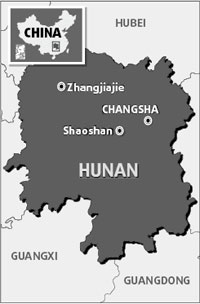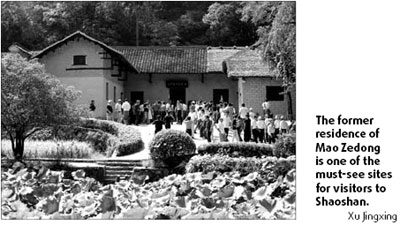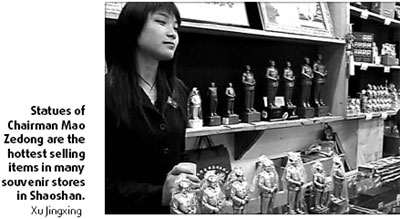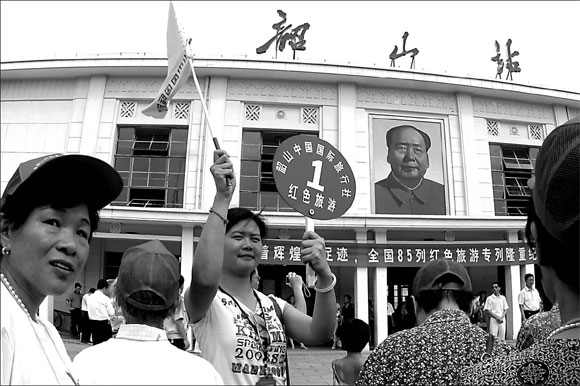Red-hot revolution
|
The huge portrait of Chairman Mao Zedong hanging on the wall of the Shaoshan Railway Station bears witness to the booming Red Tourism in Hunan Province. Zhang Mu |
The growing popularity of "Red Tourism" in China is giving Hunan Province a chance to show its true colors. A new revolution is underway at the province's old revolutionary sites, as today's inhabitants of these historical places are experiencing a rapid and dramatic improvement in their quality of life.
The model for this transformation in the province is the hometown of former Chairman Mao Zedong, the village of Shaoshan, located 130 kilometers southwest of the provincial capital, Changsha.

Since 2002, the growth of Red Tourism increased the number of Shaoshan-bound visitors from 2 million to 3 million per year. During the same period, the average per capita income of the village's 1,311 residents increased from 5,000 yuan ($664) to 7,480 ($994), according to Shaoshan's Party Secretary Mao Yushi. Mao says that today, tourism accounts for 85 percent of the village's revenue, while the remaining 15 percent comes from pig farming.
For local restaurateur and revolutionary paraphernalia peddler Mao Lianghui, who is known as one of the village's most successful business people, the growing influx of tourists has meant an increasing inflow of cash.
"When I first started business in 1993, I didn't have a place of my own," she says. "Now, I have a three-storey building." Restaurants occupy the first two floors of the building, and Mao Lianghui lives on the third.
She also owns a cement factory and runs a handful of souvenir stores in the village, where she says her hottest selling items are statues of Chairman Mao Zedong priced between 208 yuan ($28) and 3,875 yuan ($515).
And today, the entrepreneur commutes between her home and businesses in one of the three cars she was able to buy with the money she earned from the tourism boom. With her increased income, Mao Lianghui purchased an Audi, a Mazda and a Hyundai, which she drives along the village's recently paved roads.
Vendor Mao Xinbing, who runs a souvenir stall next to one owned by Mao Lianghui near Dishuidong, hasn't bought a car. He says he's saving up to expand his business instead. But he does believe Red Tourism has improved his life quality since he began his business a decade ago.
"There are more and more customers," he says.

When asked how it has changed his life, he flashes a toothy grin and puckishly rubs his belly. He adds that the prosperity that has come with Red Tourism has brought the village many modern conveniences, such as grain harvesting machines and elevators.
But he believes the improvements go beyond the material.
He says that because he engages more travelers from around the country and globe, "my perspective has become broader, and my judgment has become wiser".
Shaoshan's Party Secretary Mao Yushi, who is also a delegate to the 17th National Congress of the Communist Party of China, says the village owes much of its growing prosperity to the development of Red Tourism as a concept and industry.
"In the early years, visitors who would come here did so on an individual or family basis. But with the development of Red Tourism, many visits are being organized by schools, companies and the government, and it's obvious that more and more travelers are coming here," he says.
The influx of visitors has provided the will - a desire to lure tourists - and the means - tourism revenue - to improve conditions in Shaoshan. And in working to raise quality of conditions for Shaoshan's visitors, the village also raised the standard of living for its people.
"We feel greater responsibility to do things such as improve services, improve health and hygiene, and protect the environment," Mao Yushi explains.
A lot has changed in Shaoshan as Red Tourism boomed as a business over the past five years. Today, the roads are paved and pipes carry drinking water that meets national standards to all of the village's 456 households. Also, since 2002, the number of households with vehicles doubled to 40, and there are now 40 computers in the village.
Within the households, improvements have been made in the kitchens and bathrooms. And families have moved their pigsties from the first floors of their homes to new pens away from their houses.
According to director of the Marketing Division of the Hunan Provincial Tourism Bureau Gong Tiejun, Shaoshan is the greatest success story among the province's Red Tourism circuits.
Conditions are improving around other important revolutionary sites, most of which are former residences of important revolutionary figures, such as Liu Shaoqi, Hu Yaobang, Peng Dehuai and He Long. However, transportation and infrastructure must be further improved to tap the full potential of these locations.
"The former residences of many revolutionary figures are very far from the capital, and transportation sometimes isn't so convenient," Gong says. "At the same time, these sites weren't always well presented."
While Red Tourism moves from dipping its toes in to getting a solid foothold at these off-the-beaten-path sites, Shaoshan would almost certainly remain the primary destination of Red Tourists visiting the province.

But booming business has created some challenges to the village's tourism industry. "The competition has become stiffer," businesswoman Mao Lianghui says. "There's a fallout from the growing competition in the village, and some of my stores have suffered because of it."
But the successful entrepreneur isn't too worried about the growing rivalry among businesses in the village, which she believes could actually be a good thing in the long term.
"You just have to have self confidence and move ahead," she says. "Now that all of the businesses here are private, we must improve our service in order to remain competitive." And that, in turn, improves the city's allure as a tourist destination, she believes.
However, the village's government has been trying to reduce the number of tourism-related businesses.
Administrative law enforcement officer Su Jia says he's noticed the number of businesses decline over time.
According to him, Shaoshan has about 120 restaurants, and over the past few years, the government has been closing three to five annually in the name of orderliness and quality.
Shaoshan's Party Secretary Mao Yushi says the improvements that have come with the influx of Red Tourists are more than just material.
"There has been an improvement in the spiritual realm, in how people feel about their village," he says. "The local people have all learned from the Red Tourists from all over China that they should be proud. All of this comes from the great deeds of Chairman Mao Zedong, and villagers feel a responsibility to live up to his example."
(China Daily 10/17/2007 page23)















